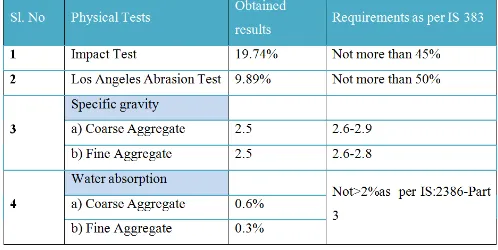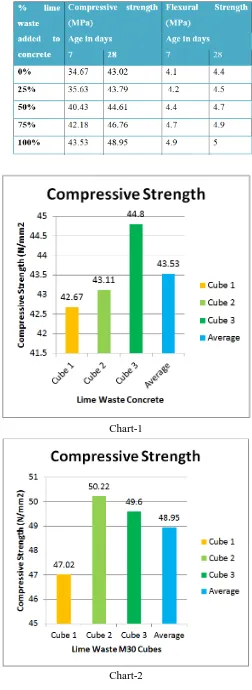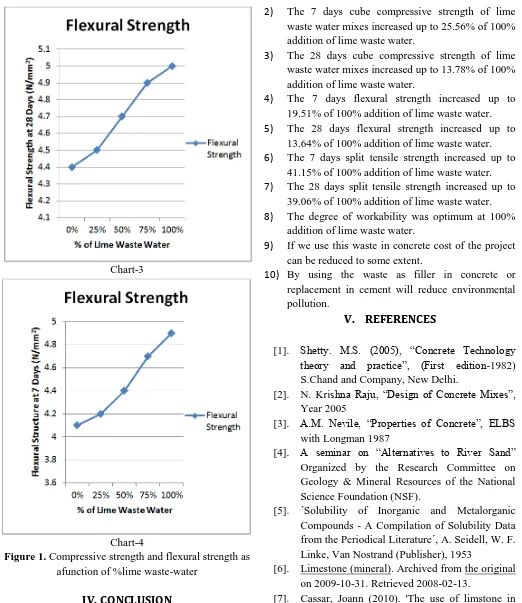© 2016 IJSRST | Volume 2 | Issue 2 | Print ISSN: 2395-6011 | Online ISSN: 2395-602X Themed Section: Science a nd Technology
An Experimental Investigation on Lime Waste Water by Partial
Replacement of Natural Water in Cement Concrete MIX
B. Naga Niranjan Kumar
1, S. Upendra
1, S. Obulesu Reddy
1, S.Mahaboob Basha
1, B.Kowsal Raja
Naidu
1, V. Satish Kumar
1, R. Hari Babu
1, Dr. M. Ashok Kumar
21Department of Civil Engineering, Dr. K.V.Subba Reddy Engineering College, Kurnool, Andhra Pradesh, India
2
Department of Mechanical Engineering, Dr. K. V. Subba Reddy Institute of Technology, Kurnool, Andhra Pradesh, India
ABSTRACT
The rapid growth in development of construction industry is leading to an increase in utilization of lime waste water due to which there has been a much scarcity in availability for construction. This overuse should be balanced by introducing certain abundantly available other natural materials which can be replaced to the waste water. The waste water seems to have same certain properties and can be used as a constituent of normal water. This can reduce the water and various ecological imbalances. The fast growth in industrialization has resulted in tones and tones of by product or waste material, which can be fly ash, crushed stone dust, silica fume, and granulated blast furnace slag, steel slag etc. By using this waste water strength will enhance the properties of concrete in fresh and hydrated states. The granite waste water is usually dumped from the sump and attracts major environmental concern. In the present work a series of tests were carried out to make comparative studies of various mechanical properties of concrete mixes prepared by using waste water .If some of the materials are found suitable in concrete making, cost of construction can be cut down .so in present study, an attempt has been made to assess the suitability waste water in concrete mixing. Cubes and beams were cast and tested for compressive strength and flexural strength. Waste water used for this project after 7 days and 28 days. The waste water is replaced in percentages of 0%, 25%, 50%, 75%, and 100%.
Keywords: Aggregate, Lime Waste Water, Compressive Strength, Split Tensile Strength
I.
INTRODUCTION
Lime is a remarkable and versatile material. It has a long tradition of use in construction, agriculture, water and waste treatment. More recently, lime has been used in numerous manufacturing and processing industries, most notably papermaking, sugar processing, steel production and the manufacture of calcium silicate bricks. This document is an introduction to lime, how it is produced, and what raw materials are required. It lays emphasis on particular lime utilization in the construction industry and the contribution it can make towards low-cost building materials. Limewater is the common name for a diluted solution of calcium hydroxide. Calcium hydroxide, Ca(OH)2, is sparsely soluble in water (1.5
g/L at 25 °C). Pure limewater is clear and colour less, with a slight earthy smell and an alkaline bitter taste of calcium hydroxide. The term lime refers to the
alkaline mineral, and is unrelated to the acidic fruit. Limewater is prepared by stirring calcium hydroxide in pure water, and filtering off the excess undissolved Ca(OH)2. When excess calcium hydroxide is added to
limewater, a suspension of calcium hydroxide particles results, giving it a milky aspect, in which case it has the common name of milk of lime. Milk of lime or a saturated solution of lime (limewater) has a ph of 12.3. It is basic in nature.
II.
METHODS AND MATERIAL
2. PROBLEM STATEMENT
for raw materials which in turn leads to price hike of raw materials. Also this demand may be due to scarcity in availability of raw materials mostly the natural water. This problem of importing normal water from other places at a higher price has brought the idea of using the locally available natural material in the place of this normal water. Lime waste-water is abundantly available at the lime shores. By this way much of the economy of construction could be saved. So, by using lime waste water from the lime waste factory as normal water replacement in preparation of concrete will save our earth for a sustainable environment. It also helps to save much of our normal water from being deployed for construction.
3. AIM AND OBJECTIVE
The objectives of this study are:
1. To determine the performance of using lime waste water as a water in concrete.
2. To determine the most economic material that can be suitably replaced for construction.
3. To fulfil safe environment by using waste materials. 4. To investigate the basic properties such as Flexural
Strength, Compressive strength of lime waste water replaced concrete in comparison with Normal water sand used concrete.
4. SCOPE OF THE STUDY
The scope of the study will be focused on the performance of concrete using lime waste water as a partial replacement with 20mm nominal maximum aggregate size. In this study the lime waste water is collected from Markapuram, markapuram Mandal, Prakasham district, Andhra Pradesh, India. The sample was taken on the lime waste factory.
5. MIX DESIGN
Mix design can be defined as the process of selecting suitable ingredients of concrete and determining their relative propositions with the object of producing concrete of certain minimum strength and durability as economically as possible. The mix design is based on as IS: 10262-2009.
Table - 1: Shows Mix Design for M30 grade
6. TEST ON MATERIALS
6.1 Cement
OPC 53 Grade of Cement Maha cement was used in this study. The following physical test should be conduct in the laboratory as per IS codes.
Table – 2: Physical Test results of cement
6.2 Aggregates
The aggregate used in this study was clean river sand and crushed stone aggregate collected from near Kurnool.
7. TESTS ON CONCRETE
7.1 Slump Test
Table – 4: Shows the slump values of lime waste water used concrete
7.2 Compaction Factor Test
Table – 4: Shows the Compaction factor values of lime waste water used concrete
III.
RESULTS AND DISUSSIONS
All specimens will be moist cured for one day and after moist curing the specimens will be water cured for required days. Traditional curing the cubes molded with the cement concrete is subjected to curing in the water Tank and then checks the strengths at the age of 7 days and 28 days.
Table – 4: Shows the Compression and Flexural strengths of lime waste water used concrete cubes and beams
Chart-1
Chart-3
Chart-4
Figure 1. Compressive strength and flexural strength as afunction of %lime waste-water
IV.
CONCLUSION
1) The compressive strength, flexural strength and split tensile strength of lime waste concrete is increases more than the normal concrete at any percentage.
2) The 7 days cube compressive strength of lime waste water mixes increased up to 25.56% of 100% addition of lime waste water.
3) The 28 days cube compressive strength of lime waste water mixes increased up to 13.78% of 100% addition of lime waste water.
4) The 7 days flexural strength increased up to 19.51% of 100% addition of lime waste water.
5) The 28 days flexural strength increased up to 13.64% of 100% addition of lime waste water.
6) The 7 days split tensile strength increased up to 41.15% of 100% addition of lime waste water.
7) The 28 days split tensile strength increased up to 39.06% of 100% addition of lime waste water.
8) The degree of workability was optimum at 100% addition of lime waste water.
9) If we use this waste in concrete cost of the project can be reduced to some extent.
10) By using the waste as filler in concrete or replacement in cement will reduce environmental pollution.
V.
REFERENCES
[1]. Shetty. M.S. (2005), “Concrete Technology theory and practice”, (First edition-1982) S.Chand and Company, New Delhi.
[2]. N. Krishna Raju, “Design of Concrete Mixes”, Year 2005
[3]. A.M. Nevile, “Properties of Concrete”, ELBS with Longman 1987
[4]. A seminar on “Alternatives to River Sand” Organized by the Research Committee on Geology & Mineral Resources of the National Science Foundation (NSF).
[5]. ´Solubility of Inorganic and Metalorganic Compounds - A Compilation of Solubility Data from the Periodical Literature´, A. Seidell, W. F. Linke, Van Nostrand (Publisher), 1953
[6]. Limestone (mineral). Archived from the original on 2009-10-31. Retrieved 2008-02-13.
"Lake-Middle Devonian basin-margin fish bed". Journal of the Geological Society 156 (3): 535– 548. doi:10.1144/gsjgs.156.3.0535.
[9]. Cassar, Joann (2010). 'The use of limstone in historic context'. in Smith, Bernard J. (ed.), "Limestone in the Built Environment: Present-day Challenges for the Preservation of the Past". Geographical Society of London. p. 13-23. ISBN 1862392943. ISBN 9781862392946. [10]. Dunham, R. J. (1962). "Classification of
carbonate rocks according to depositional textures". In Ham, W. E. Classification of carbonate rocks. Am. Assoc. Petroleum Geologists Mem. 1. pp. 108–121.
[11]. "Nutrient minerals in drinking-water and the potential health consequences of consumption of demineralized and remineralized and altered mineral content drinking-water: Consensus of the meeting". World Health Organization report. [12]. IS: 10262-2009 Recommended guide lines for
concrete mix Design
[13]. IS: 383-1970 Specification for coarse and fine aggregates From natural resources
[14]. IS: 516-1959 Methods of tests for strength of concrete.
[15]. IS: 5816 Method of test for splitting tensile strength.
[16]. IS: 4031-1996 (Part-1) Determination of Fineness by dry sieving.
[17]. IS: 4031-1988(Part-3) Determination of soundness.
[18]. IS: 4031-1988(Part-4) Determination of Standard consistency of Cement paste
[19]. IS: 4031-1988(Part-5) Determination of Initial and Final Setting Times.
[20]. IS:4031-1988(Part-7) Determination of Flexural Strength of masonry cement paste.
[21]. IS: 2386-1963(Part-1) Particle Size and shape. [22]. IS: 2386-1963(Part-3) Specific Gravity
absorption and bulking of fine Aggregate. [23]. IS: 2386-1963(Part-4) Aggregate Impact value,
Abrasion value.
[24]. IS: 1489-1991 Specifications for Portland Pozzolanic Cement.


